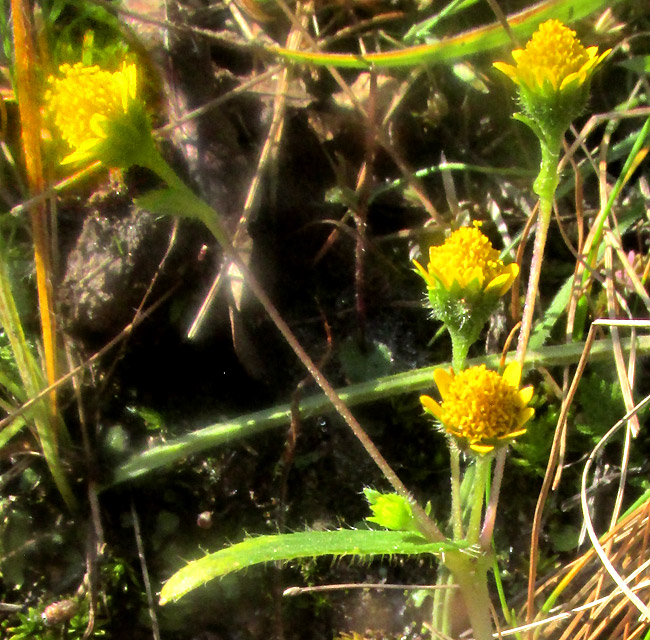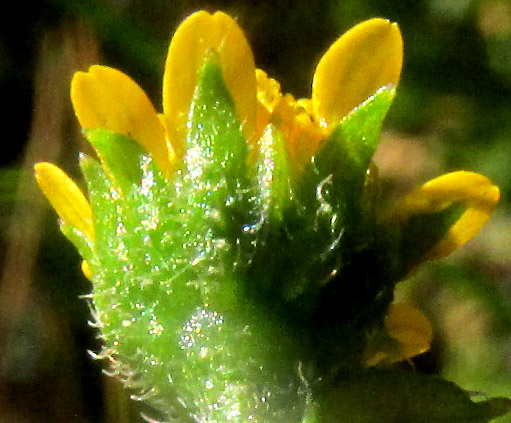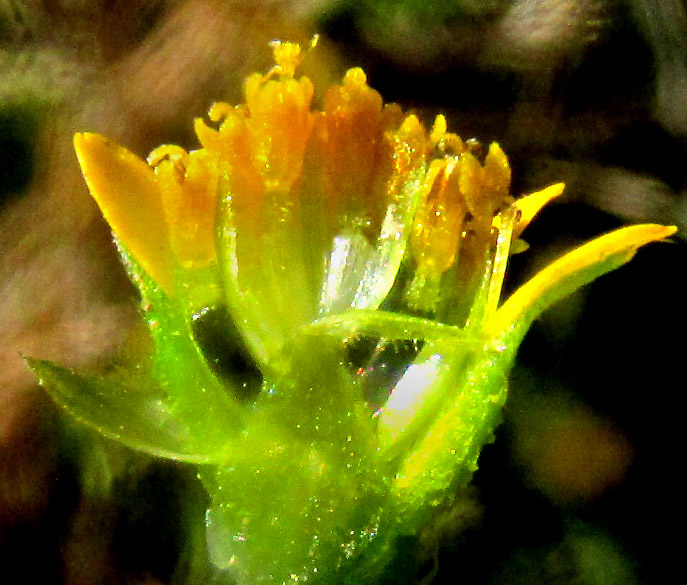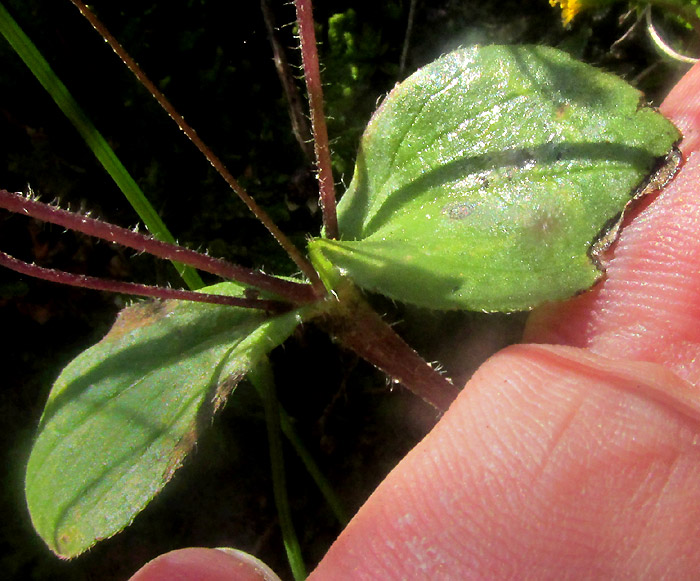Excerpts from Jim Conrad's
Naturalist Newsletter
Entry dated November 8, 2023, from notes taken near Cascadas de La Piedad waterfall 3kms NW of the community of San Pablo, municipality of Almeaco de Bonfil; bedrock of igneous andesite; N20.1021°, W100.0035°, elevation 2360 meters (7750ft); extreme southern Querétaro state, MÉXICO
JAEGERIA HIRTA

The above yellow-flowered wildflower prospered among mosses, lichens and grasses on a near-vertical slope with loose rocks at the rim of the west-facing cliff dropping into the canyon about 100m downstream from the Cascada de La Piedad, or Piety Waterfall. Most of the day the spot was shaded by a nearby boulder. Note that the plant's lower leaves arise in pairs opposite one another, while upper leaves are more slender and arise singly from the stem.

With flowering heads composed of many tiny, closely packed disc florets with cylindrical corollas forming an "eye," which was surrounded by petal-like ray florets with flat, tongue-shaped corollas, this had to be a member of the largest of plant families, the Composite/Aster/Sunflower Family, the Asteraceae. Each flowering head, or capitulum, was subtended by a small, narrow leaf, above which the capitulum's peduncle was fairly short. The stem below each leaf was slender and stiff, giving the impression that each capitulum grew atop a long peduncle.

It can be hard to determine which of the many yellow-flowered, Aster-Family species one might meet, so it was encouraging to note that the above capitulum bore ray florets which, relative to most species' capitula, were disproportionately short relative to the eye's width. Each ray floret corolla bore a single indentation at its tip.

The green, bowl-shaped involucre from which the florets arose were composed of a single series of bracts, as opposed to the overlapping series of spiraling bracts found on most Aster Family species. The bracts' bases usually bore a few stiff, thick-based trichomes. Notice how each ray floret corolla is immediately subtended by a green bract.

All the above nit-picking details are useful for identification, but details revealed in the above picture are among the most helpful for determining which of the Aster Family's approximately 417 Mexican genera of the world's 1900 genera we might have. The broken-open capitulum seen above shows that the disc florets cover a cone-shaped "hill," the receptacle. Most receptacles are flat or only slightly raised. The black items are mature, one-seeded fruits; atop the receptacle the fruits are immature. Note that each fruit is partially separated from its neighbor by a shoehorn-shaped scale, the palea. Many Aster Family genera produce no paleae, so this is a major field mark. Just as important is the fact that atop the fruits there are no slender white hairs which later would form parachutes for dispersal, plus there are no spines and no scales. Our plant's fruits are equipped with no pappi at all, though most species possess them. Also important, though not clearly seen in the photo, is that both ray and disc florets produce fruits.

The lower leaves were three-veined from their bases, and their bases attached to the stem with no slender petiole. Stems were dark purplish and bore stout, stiff, broad-based hairs.
In this part of Mexico, if your plant's flowers produce no pappi atop the fruits, but palea separate them in the heads, and if both disc and ray florets are fertile, and the disc florets stand on a cone-shaped receptacle, plus the involucral bracts are arranged in just one series, you have the genus Jaegeria. That's a fairly small genus, comprising only 15 or so species occurring only in an area from Mexico south through tropical South America. The genus was discovered during the Humboldt and Bonpland expedition to the Americas taking place between 1799 and 1804, and the name was first published by the German botanist Karl Sigismund Kunth in 1818.
In our part of upland central Mexico, four Jaegeria species have been documented. Here, if you have a Jaegeria with yellow ray florets less than 2mm long, you have JAEGERIA HIRTA, with no English name.
Jaegeria hirta commonly and weedily occurs in highlands, especially in moist and disturbed places, throughout Mexico south through South America. It's highly variable in appearance and, depending on location, flowers throughout the year, though mostly during the rainy season.
The 2021 study by Maite Lascurain-Rangel and others entitled "Plantas americanas utilizadas como condimento en la cocina mexicana" reports that Jaegeria hirta is used in Mexico as flavoring in stew, and eaten raw. Several works mention the species as a useful component of pastures, for livestock grazing. The 2018 study by Oscar A. Aguirre-Obando and others entitled "Actividad larvicida de extractos vegetales de la familia Asteraceae y modelación matemática para su uso en el control de poblaciones de Aedes aegypti" finds extracts of Jaegeria hirta toxic to mosquito larvae, thus useful in the effort to diminish mosquiteo-borne illnesses such as dengue, chikunguña and Zika. And the 2019 study by Z. Aguirre-Mondoza and others entitled "Arvenses asociadas a cultivos y pastizales del Ecuador," says that in Ecuador an infusion of the whole plant is used to treat indigestion.